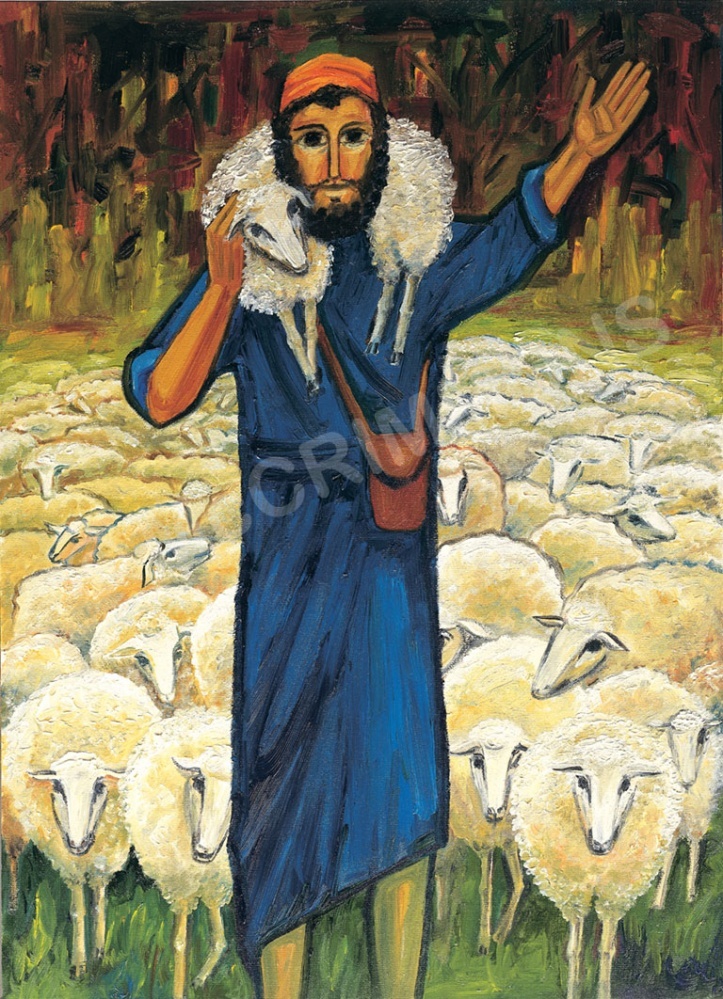Artwork
by the Benedictine Sisters of Turvey Abbey
December
20th: 'O Key of David, and sceptre of the house of Israel, who open and none
may close, who close and none may open, come and bring out of prison the
captive who sits in darkness and the shadow of death.'
'O
Clavis David, et sceptrum domus Israel:
qui aperia, et nemo claudit; claudis. et nemo aperit:
veni, et edu vinctum de domo carceris,
sedentem in tenebris et umbra mortis.'
The text is based on Revelation 3:7, recalling Isaiah 22:20-22 and 42:7. For
the Jewish people the key or sceptre of David was depicted as a 6-pointed star,
which was a symbol of God and of the Messiah. A clear reference of this is
found in Numeri 24:17, and in the star which led the Magi to Bethlehem (Matthew
2:2).
The key, the sceptre, the star is Christ who through his death and resurrection
opened the gates of hell. The banner is based on the Eastern 'Anastasis',
showing Christ victoriously rising from the tomb, trampling the gates of death
underfoot and pulling Adam and Eve out of their graves, and with them the whole
human race.
The O Antiphons are a highlight of the Church's Advent Liturgy:
from December 17th - 23rd they frame the Magnificat at Vespers.
Rich
in symbolism and meaning they take us right from the beginning of creation,
through the centuries of the world's waiting for the promised Messiah, calling
upon him who was hidden in signs and symbols, and revealed when the fullness of
time had come, leading us to the Mystery of the Incarnation and beyond, to the
Paschal Mystery, the coming of the Holy Spirit and the Parousia (Christ's
second coming).
The
exact origin of the Latin texts is unknown. They may date from the sixth
century. There is evidence to suggest that the texts were in liturgical use in
Rome in the eighth century. Both the original Latin texts and an English
translation are given here.
Arriving
at the 7th Antiphon on December 23rd, we may discover that the letters of the
Latin invocations, read from the last up to the first, form a wonderful
acrostic (ERO CRAS), like God's answer to our prayer:
Dec. 17: Sapienta (O Wisdom)
Dec. 18: Adonai (O Adonai [Lord])
Dec. 19: Radix Jesse (O Root of Jesse)
Dec. 20: Clavis David (O Key of David)
Dec. 21: Oriens (O Rising Sun)
Dec. 22: Rex Gentium (O King of the Nations)
Dec. 23: Emmanuel (O Emmanuel)
ERO CRAS: I WILL BE HERE
TOMORROW
Christmas: O Wonderful Exchange (Antiphon
from the Greek Liturgy "O Wonderful Exchange! The Creator of the human
race took to himself a human body and was born of a virgin, and becoming man he
granted us divinity.")
Click here to view all 8
images in greater detail (opens in new window).
Roller/Pull-up Floor Standing Banner: These banner features
a stylish wave design and supports a two-part, telescopic pole that allows the
banner to achieve a commanding height of up to 2m.and printed on a 300gsm grey
block polymer The banner itself feeds from just above floor level, concealing
the base unit and allowing your design to take centre stage. The compact base
allows the Roller Banner to function in environments where space is limited.
The unit weighs 5.6kg and comes with a padded carry bag.
*180 day warranty from date of delivery with any mechanical or print fault.
Dimensions: 2000mm x 850mm
Delivery: Please allow 10-14 days from date of order.
Click
here to view our full range of Roller Banners.
If you have any queries or would like any further information use
our ‘Contact Us Form’,
phone (01702) 218956 or email sales@mccrimmons.com






